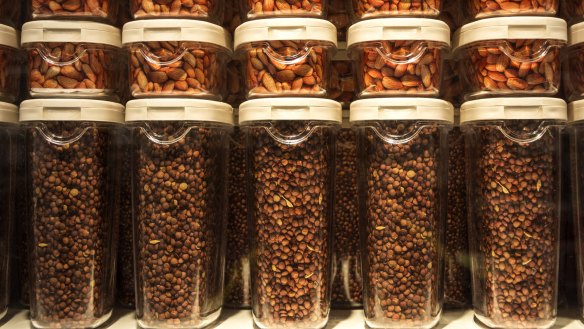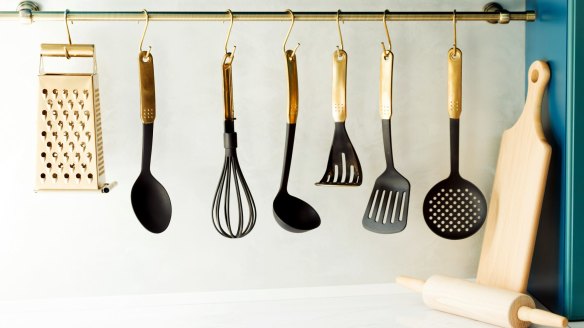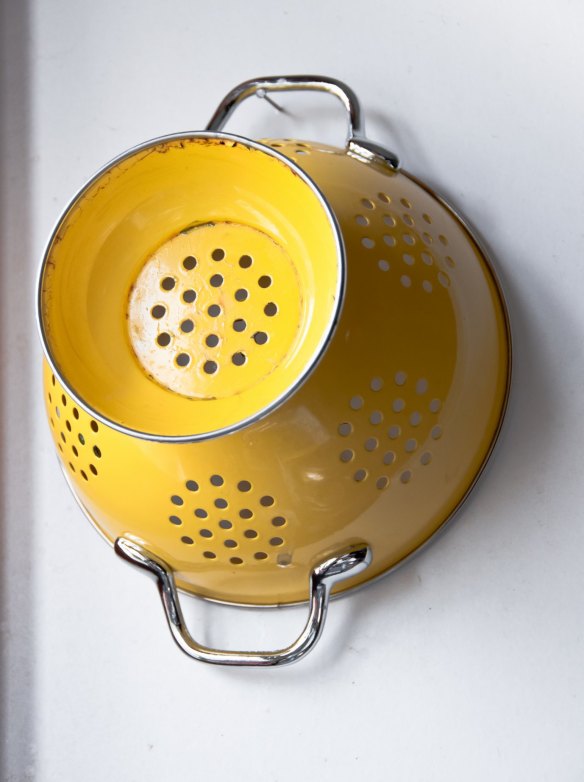Nine simple kitchen storage solutions

Operating out of a kitchen with next to no storage is stressful. Those deep dark cupboards, shallow drawers, or no storage at all can send even the calmest cook spare.
We asked organisation and interior design experts for their best tips for carving out storage space in a kitchen with barely-any, and discovered that with clever editing, vertical thinking, and a little creative know-how, even the most storage-challenged space can work like a dream.
1. Edit brutally
Begin by paring back your kitchen contents so you only keep the essentials.
"Our first instinct is to want a home for all our belongings," says Nicola Evans from Sort It Now. "There is a perception that if I just buy or install this I'll be more organised, but these additional items only allow us to hold onto unnecessary items that we never use."
A ruthless edit and decluttering opens up storage potential. "Throw out excess items such as broken crockery, odd plastic containers and expired food," she says. "Be realistic about how much you need. Can you exist with 10 mugs instead of 20? Once you have edited you can organise back into your space."

2. Archive
"Put every kitchen item you own in another room, then put back only the things used in the past month," says Sonia Simpfendorfer, Nexus Designs creative director. "Spiraliser, bread maker, Christmas platters? If you store all the rarely used items in clearly marked plastic storage tubs, you will have more space."
3. Steal sneaky space

"Any additional storage needs to fit within the footprint of the area of the home in which it will be [used]," says Robyn Amott from Bless this Mess. "Zoning is key."
Simpfendorfer agrees, and says underused nooks, cupboards or blank walls should be snatched up.
"We've snuck appliance storage behind a sliding splashback, taken over a broom cupboard, extended kitchens beyond their boundaries and turned verandahs into butler's pantries," Simpfendorfer says.
"Add a freestanding [sideboard] against a blank wall in your dining space and store items you barely use like specialised appliances. Stack crockery and cookbooks on a tall, shallow, open-shelf unit against a wall nearby."
4. Plastic fantastic
Buy one family of stackable storage containers, add labels and use them to store dry goods.
"Use rectangular shaped containers rather than round as they waste space," says Evans. "Use the same type so they stack uniformly together."
5. Think vertically
"Vertical space is valuable real estate," says Amott. "Add floating shelves for frequently used items such as coffee mugs, attach spice racks to the wall nearest the cooktop, and use the inside of the pantry door."
A pegboard with moveable hooks can be used to hang everything from soup ladles to saucepans. Hang more hooks on the backs of sink cupboard doors for clumsy items such as colanders and chopping boards.
"I like to add a utensil rail to the splashback," says Simpfendorfer. "It frees up drawers and looks great."
6. Make use of the unusable
Navigate deep cupboard space to make it more accessible. "Categorise contents and store them in containers," says Georgie Rees from Cutterfly. "It means you are only shuffling a few containers to get to the items at the back instead of rearranging the whole shelf every time. Extra points if the containers are on wheels."
7. Like with like
"Have just one home for each category of item," says Amott. "Keep like with like items together based on frequency of use. It allows easy access, provides a limit for the amount of content within each category, and ensures we use what we have."
Evans agrees: "Use deeper storage containers to group like items. They can then act like drawers and be easily slid in and out as needed."
8. Waste not an inch
Remove wasted air space in storage cabinets by adjusting shelf heights. "Often they only accommodate the height of the tallest item," says Amott. "Adjusting them makes more shelf space that is also accessible and visible."
9. Visual access
When you can easily see each item, there is a greater chance it will be used.
"A lazy susan is perfect for overhead cupboards near the cooktop or sink," says Amott. "It brings the content from the back of the cupboard to the front with one spin.
"Also, products that are clear or acrylic ensure [visibility]. It makes all the difference."
The best recipes from Australia's leading chefs straight to your inbox.
Sign up